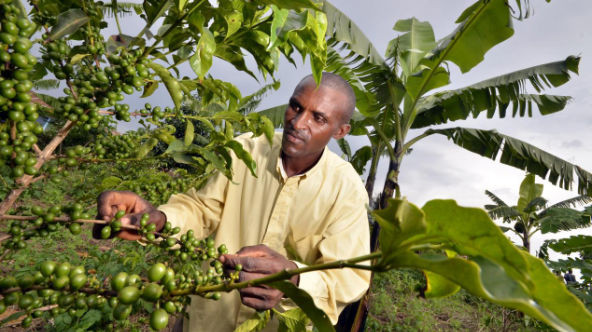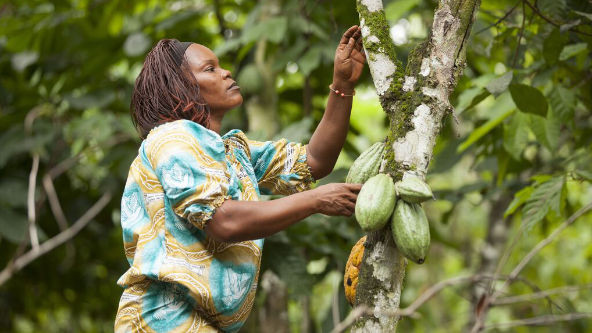 A farmer in Central Africa grows coffee for export markets alongside bananas for domestic markets. (Photo courtesy of CIAT)
A farmer in Central Africa grows coffee for export markets alongside bananas for domestic markets. (Photo courtesy of CIAT)
In the Ugandan coffee sector, smallholder farmers are starting to get a better deal. There, since 2003, a network of coffee cooperatives called the National Union of Coffee Agribusinesses and Farm Enterprises (NUCAFE) has been empowering smallholders to maintain ownership over the coffee they grow all the way through the value chain, from harvest to roasting. Two-hundred farmer co-ops with 1.5 million individual members pay NUCAFE a fee to market their beans, and cooperative members can grade and roast their beans at the organization’s facilities.
Now that buyers—rather than middlemen—pay cooperatives for the coffee beans, farmers are reaping the rewards of their work. Members of NUCAFE have increased their coffee incomes by an average of 250 percent, according to a 2018 study by Santa Clara University.
NUCAFE’s story is unusual and tantalizing. What could this example and others like it tell us about how to make the big steps forward that smallholder farmers need? With 10 years left to achieve the United Nations’ Sustainable Development Goal (SDG) 1—no poverty—more than 730 million people remain below the World Bank poverty line, and approximately two-thirds of them work in agriculture. This is unacceptable, and for global food and agriculture companies that depend on smallholder-grown commodities, it complicates supply security, cost, quality, and corporate reputation. Unfortunately, there are few pathways proven to lead smallholders out of poverty at scale. Research in 2018 by the Farmer Income Lab, a collaborative “think-do tank” founded by Mars, Incorporated, found that most smallholder farmer programs boost incomes by 50 percent or less, when they would need to double or triple their incomes to get out of poverty.
In spring 2019, the Farmer Income Lab commissioned outreach and analysis designed to identify programs with the highest-possible income increases and rapidly assess what they might have to add to the body of knowledge about “what works” to increase farmer incomes. After crowdsourcing and working to validate cases from more than 80 experts and practitioners in this field, we (the authors) identified nine initiatives that increased incomes by at least 100 percent for thousands or even millions of farmers across a range of commodities and geographies. We asked ourselves: What lessons might these rare, high-performing cases offer on how to take major, structural steps forward on farmer income? And are there implications for global food and agriculture companies that rely on these farmers?
 A farmer harvests cocoa in Cote d'Ivoire for Mars, Inc.'s supply chain. (Photo courtesy of Mars, Inc.)
A farmer harvests cocoa in Cote d'Ivoire for Mars, Inc.'s supply chain. (Photo courtesy of Mars, Inc.)
Are you enjoying this article? Read more like this, plus SSIR's full archive of content, when you subscribe.
In an initial analysis of these nine cases, we observed three patterns we believe help explain their exceptional success. The patterns expose the importance of putting farmers at the center of business practice, and making fundamental shifts in the way the benefits and risks of supply chains and commodity sectors are distributed. The insights and implications for global food and agriculture companies, and their partners in government and civil society, are significant. Our review also confirmed that the most successful cases share the basic good practices of bundling together multiple interventions to tackle the multi-dimensional nature of poverty, and tailoring support and services for farmers based on a deep understanding of their needs and the local context.
Three Patterns That Help Explain Success
1. Greatly strengthening farmer market position. The cases we reviewed strengthened the terms of farmers’ participation in markets. They offered greater stability, negotiating power, and choice so that farmers have greater control over when and where to sell, and for what prices. They did this by forming and strengthening farmers’ organizations; making direct connections between farmers and buyers; offering and honoring long-term contracts; and providing services, such as credit and storage, that allow farmers to sell when it’s most profitable. This goes far beyond today’s most common approaches to increasing farmer income, which largely focus on improving farmers’ productivity.
A standout in terms of strengthening farmers’ market position is Amul, a dairy cooperative in the state of Gujarat in India. Amul was founded in 1946 after a group of farmers rebelled against local middlemen. The cooperative is vertically integrated, controlling every stage of the value chain (including production, procurement, processing, and marketing), and because the farmers are the owners, they set the price. So while dairy farmers globally earn about 30 percent of the price of the final product, currently 3.6 million Amul farmers can earn up to 80 percent. The cooperative’s growth has been impressive: Between 2011 and 2018, it climbed from a rank of 18th largest dairy processor in the world to ninth, according to the International Farm Comparison Network, a provider of dairy market information. This growth enabled Amul farmers to increase their milk incomes by 300 percent, according to cooperative records.
2. Businesses playing an important role, but not through business as usual. The cases offer a perspective not only on what needs to change—the market position of farmers—but also how to make that happen. Of the nine cases we reviewed, six are business-driven, and the remaining three are development programs that seek to catalyze and support new business approaches. This suggests that companies can have a serious, positive impact on farmer incomes, if they design and manage their business models to serve farmers’ interests as well as their own. The companies involved in these cases include buyers of agricultural raw materials offering long-term contracts, guaranteed markets, and predictable (in some cases, higher-than-usual) prices. They also include farmer-owned companies providing services, as well as processing and marketing value-added products themselves. In some cases, these companies are only viable if the farmers they source from are viable too.
One example of a successful, if unconventional, business model is the Philippine agribusiness company Kennemer Foods International. To encourage smallholder farmers to plant cacao between their coconut trees, it offers farmers 10-year contracts and guarantees to purchase all of the beans they produce. What’s more, the company has founded its own financing arm and partnered with a government bank to provide access to long-term financing with flexible terms. This makes it possible for farmers to wait to begin repaying until after the seven-year mark, when cacao trees are fully productive. As a result, more than 12,000 smallholder farmers (and counting) have joined the company’s supply base, creating a steady stream of cacao for Kennemer. About four years in, the initiative is already improving farmers’ income by 200-250 percent, according to the company’s purchasing data.
3. Tapping into growing domestic markets. Conventional wisdom among global companies suggests that to earn more money, smallholder farmers should tap into export markets. Yet in reality, many domestic agricultural markets are less demanding, larger, and growing far faster. In more and more countries, population growth, urbanization, and economic development are rapidly expanding domestic food demand, and fueling the rise of modern supply chains serving domestic food companies and retailers. Most of the cases we reviewed emphasized some degree of selling into these domestic supply chains.
Project Nurture, a partnership between The Coca-Cola Company, the Bill & Melinda Gates Foundation, and the nonprofit TechnoServe, was designed to make it viable for fruit growers in Kenya and Uganda to open up two new markets for smallholder farmers living in poverty: 1) a new export market for high-grade mango and passion fruit for export, and 2) a new domestic market for slightly blemished fruits that met quality standards for juice processing for the company’s African supply chain. This model benefited Coca-Cola, as it was able to stop importing fruit juice puree from abroad, and it opened up a major new market for farmers. Between 2010 and 2015, nearly 54,000 farmers increased their fruit revenues by an average of 142 percent, according to a 2015 analysis by TechnoServe.
Translating Lessons Into Action
The high-performing cases we crowdsourced and reviewed show what is possible, and encourage us not to settle for results that are good but not good enough to achieve SDG 1. These cases also provide clues about how to do just that: by strengthening both farmers’ productivity and market position, by building profitable business models with farmers at the core, and by taking advantage of fast-growing domestic market opportunities.
These patterns suggest three takeaways for global food and agriculture companies that aim to improve farmer income in their supply chains:
- Work with farmers as strategic business partners. Understand what farmers need to thrive in the business of farming. Then see what you can do to meet their business needs through your business practices, social investments, and engagements with government, civil society, and the donor community. That way, farmers can meet your requirements now and into the long term.
- Revisit your purchasing practices. Re-examine the way you buy commodities grown by smallholders and the way you engage with your direct suppliers. Is it feasible to adopt practices like long-term contracts or predictable, even premium prices, or to institute a preference for suppliers that do? Act where you have leverage. It may be necessary to engage pre-competitively at the industry level and with government to help level the playing field for major change in purchasing practices.
Start now—poverty can’t wait. We have just 10 years to achieve SDG 1, and the risks to global businesses associated with farmer poverty are mounting—including supply security, cost, quality, and business reputation. Don’t wait for undisputable evidence; help test these findings. Do they hold up? Are there other important factors we haven’t yet identified? We need action, experimentation, and learning to find out. The private sector is hailed as nimble, innovative, and entrepreneurial, and it’s time to use these qualities to eliminate poverty in global supply chains.
Support SSIR’s coverage of cross-sector solutions to global challenges.
Help us further the reach of innovative ideas. Donate today.
Read more stories by Joost Guijt, Uwe Gneiting, Heather Pfahl & Beth Jenkins.

